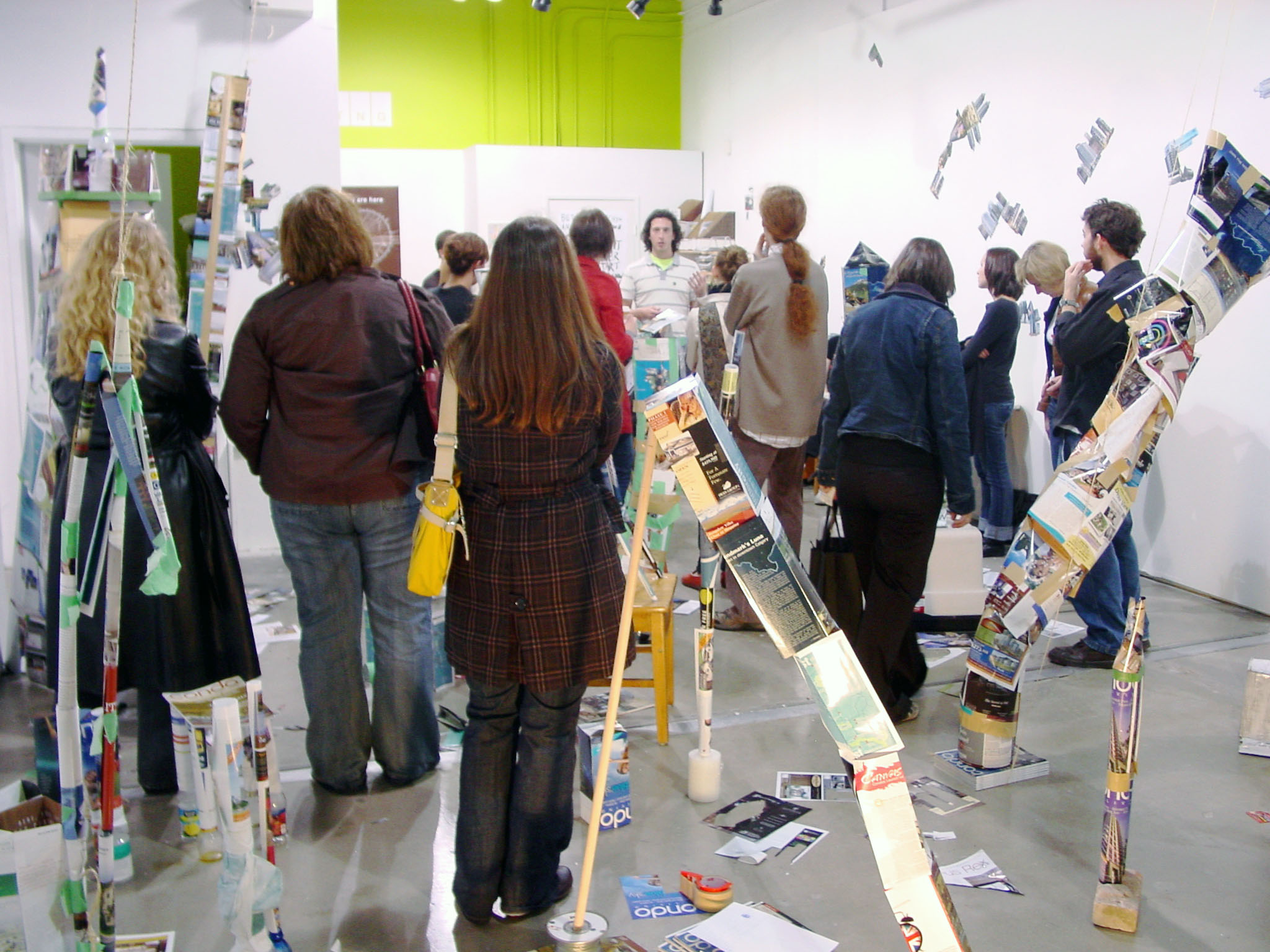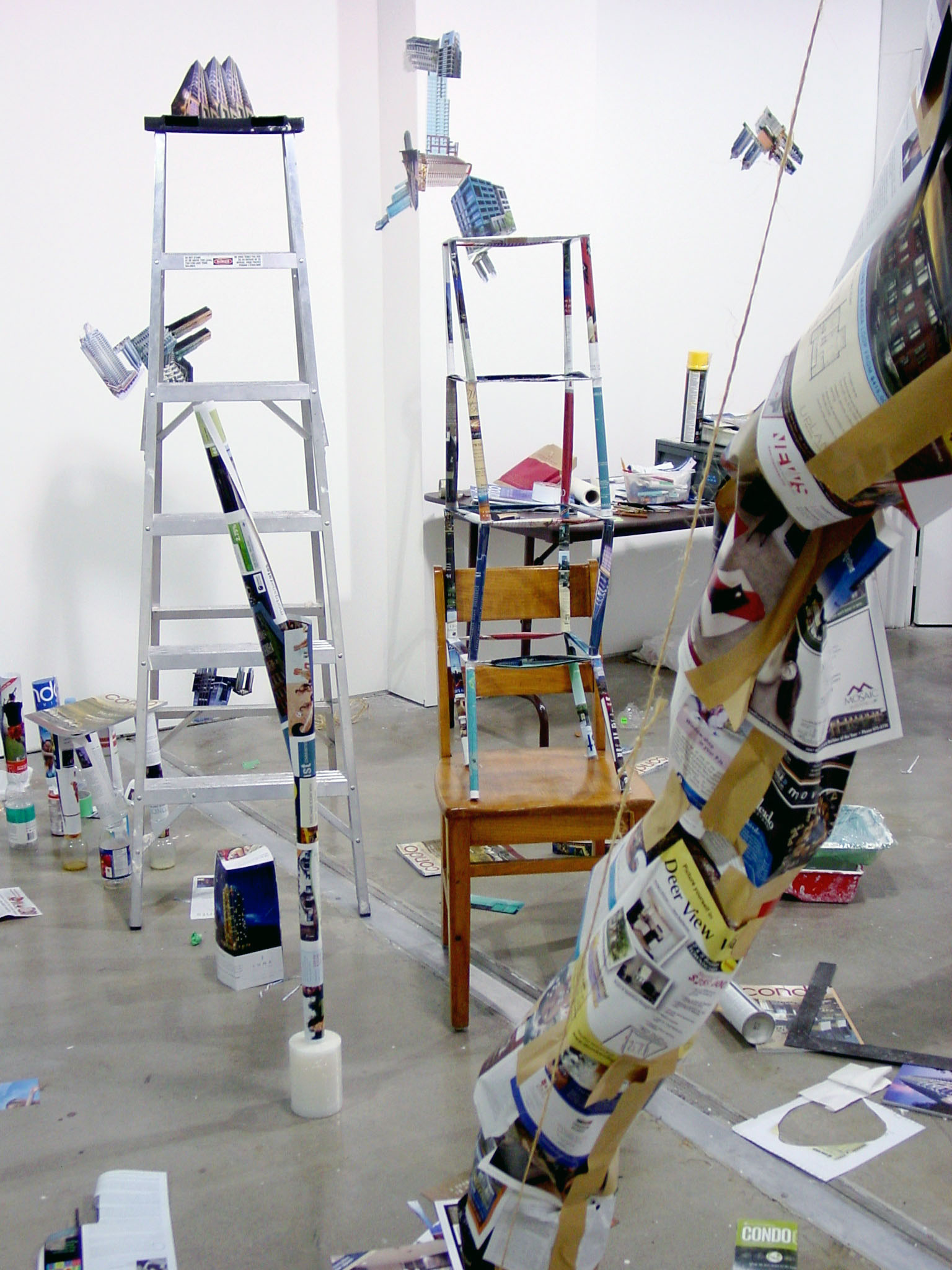
Towers
Scott Rogers
September 5 - October 4, 2008

I don’t live in Calgary. I live in Saskatoon where we are experiencing our own particular kind of real estate boom and the first wave of condominium development. This is all old har for Calgarians, many of whom have witnessed the boom-bust cycle more than once. Yet, in Saskatoon the spectacle of rapid development is all new and offers an interesting perspective on Towers, Scott Rogers exhibition at The New Gallery.
Until very recently artist-run-centres and artists needing studio space have had the luxury of inexpensive accomodation in the historical warehouse buildings of Saskatoon. Even though the recent conversion of these buildings has resulted in the eviction or displacement of cultural-producer tenants, there are some positive aspects to this transformation of downtown. Many of these buildings were underused and are now finding new life in reuse rather than creating new construction that has no heritage benefits and has a larger environmental impact. These projects promote an urban density which will in turn promote much needed amenities in these historically underserved neighborhoods as well as counteract the environmental impact of suburban development and its associated lifestyles.
Of course, the negative aspects of this trend are also evident in Saskatoon: gentrification, increased rental rates, fewer rental properties as these are replaced with condominiums. Although these issues are of concern to Rogers they are not at the core of Towers’ conception. Rather, Towers is an engagement with the cycle of speculation, development, decay and redevelopment. Saskatoon is at the earliest stage while Calgary is at the latest.
The first phase of this cycle is characterized by optimism: rejuvenation of neighborhoods, reuse of historical buildings and economic growth through the construction industry. Yet in Calgary, as examined in Towers, this phase is subject to trends and taste. More desirable buildings will be developed, original ones will be vacated and fall into disrepair, slowly becoming neglected and therefore transition into lower income or vacant properties. There is then a market for more condominiums, more new construction and the cycle continues.
Rogers considers this cycle to be an inevitable manifestation of the ‘capitalist machine’. In Towers Rogers uses a number of strategies to counter this cycle driven by capitalism. These can be characterized as:
Speculation and Development: The first phase of Towers establishes the gallery as a ‘construction site’ rather than an exhibition space. The act of not exhibiting art, as in Robert Berry’s exhibition consisting of a notice nailed to the gallery door announcing: “For this exhibition the gallery will be closed” is occasionally used to counter the capitalist notion of art-as-consumption. In this case, the gallery is open but is used as a studio space more so than an exhibition venue.. During this phase of Towers Rogers will be in consultation with other artists and participants to develop the design of the condominium sculpture that will be constructed in the second phase of this project. An approach to art-making through consultation, collaboration and consensus further disrupts the capitalist value, or consumption of this project. It is during this ‘development’ stage that the sculptures or ‘towers’ will be constructed.
Decay: Although this phase of the exhibition is characterized by the presence of actual sculptures in the gallery space, it is actually an illustration of the ‘decay’ phase of the condo cycle. Rogers will use promotional condominium brochures to construct scaled towers of the designs developed in the Speculation and Development phase of the project. The flimsy construction materials used in the sculptures reference the unstable and disposable nature of condo development as the sculptures will inevitably topple over in the course of the exhibition.
Redevelopment: In the final phase of Towers, the audience will be invited into the gallery to witness and participate in the destruction of the sculptures. Here again Rogers defies capitalist tendencies towards art consumption by destroying any consumable aspects of Towers. Of interest here is that Rogers does not present a true ‘redevelopment’ phase and in effect breaks the condo development cycle by returning the gallery to its empty state.
As Rogers explores the impermanence of condo development he is distinguishing a difference between the economic value of real estate development and the value of cultural production, collaboration and art. With Saskatoon at the earliest stage of this cycle, Rogers suggests that we all have to look forward to its entropy unless cultural value can be interjected into the process.
- Donna Wawzonek
Donna Wawzonek is a curator, writer and cook and stuff.
Scott Rogers is a visual artist, writer and facilitator currently based in Calgary, Canada. His practice combines studio and academic research into site-specific, ephemeral, lo-fi and collaborative projects. He has shown his work in group and solo shows throughout Canada as well as internationally in Germany, the United States and Ireland. Upcoming solo and two-person exhibitions include Eastern Edge Gallery (St. John’s), Eyelevel Gallery (Halifax), and Stride Gallery (Calgary). Scott was artist in residence at Church Basement in Saskatoon in July 2008 and will be participating in residencies in Iceland and the Yukon in 2009.
Specifically, Scott would like to thank the Canada Council for the Arts and Alberta Foundation for the Arts Alberta Creative Development Initiative for its assistance in funding this project.











